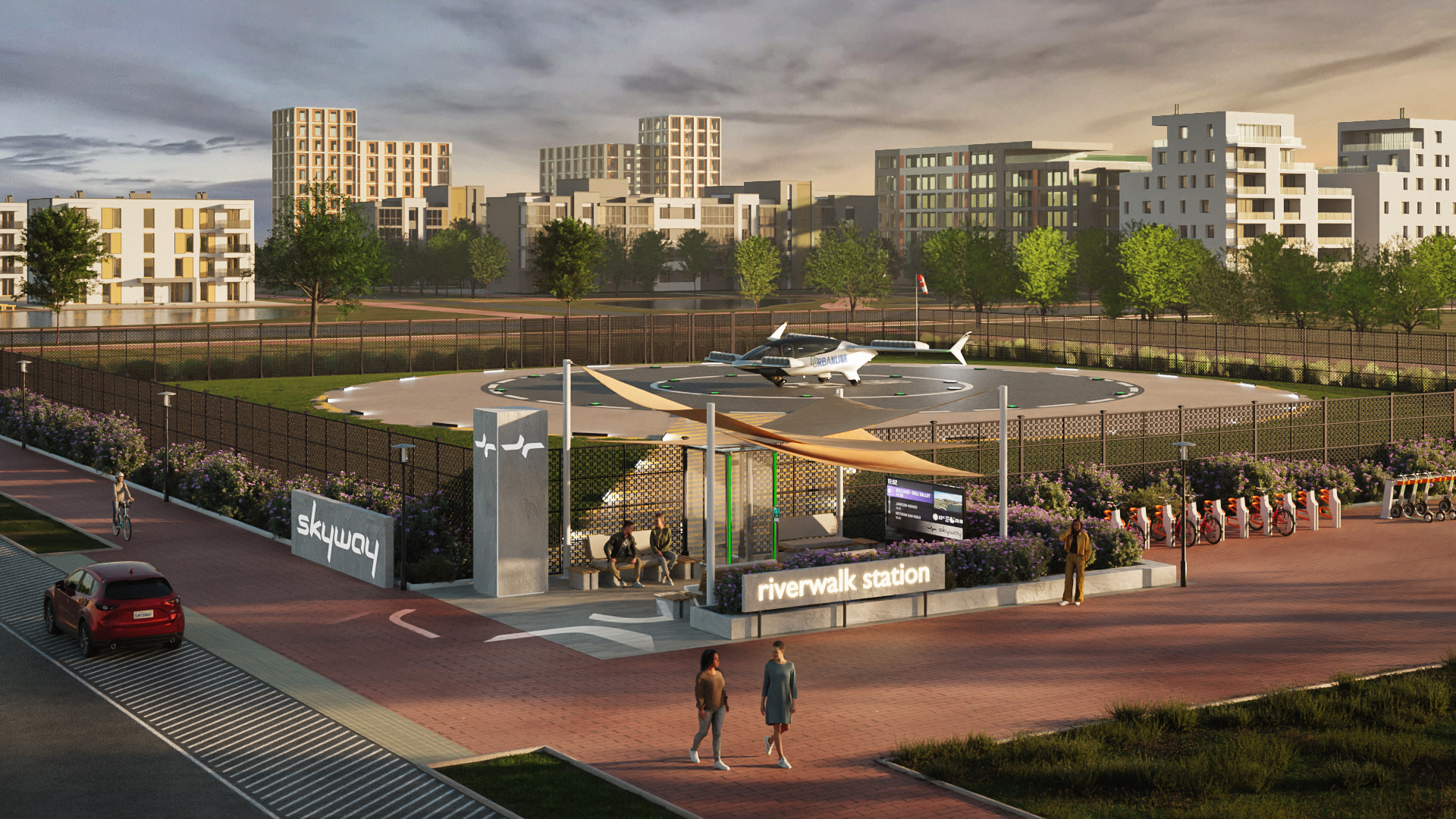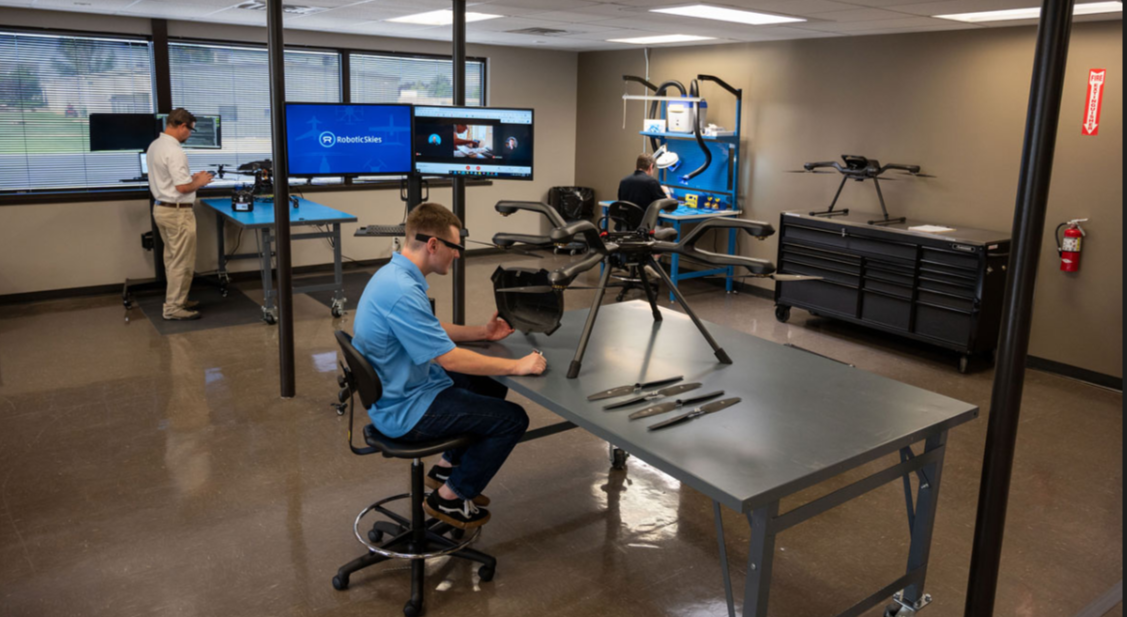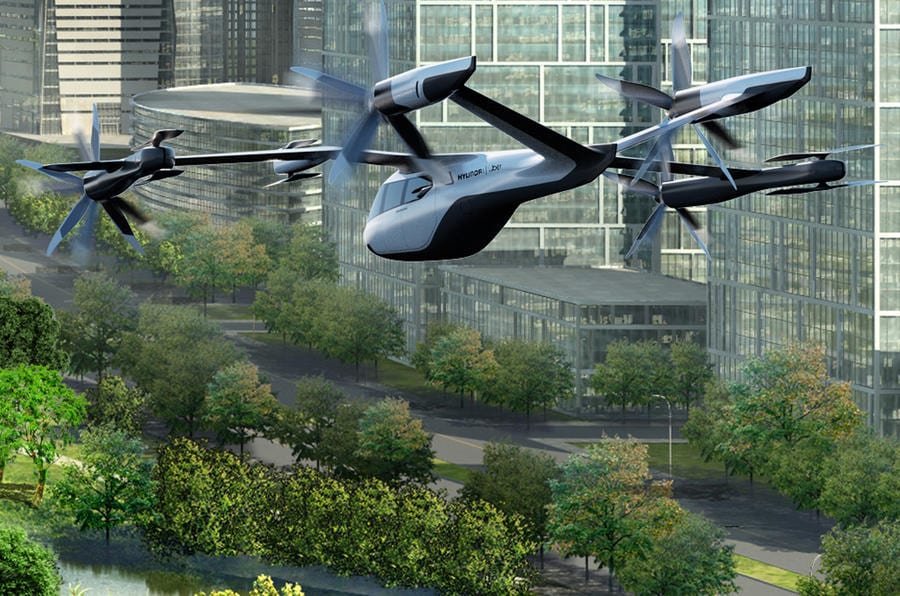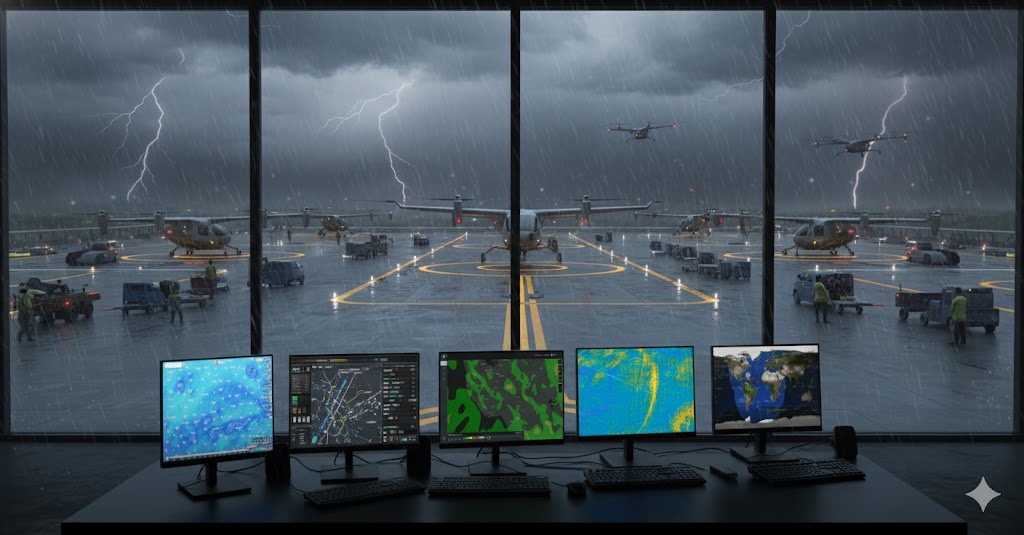Advanced Air Mobility (AAM) represents a major shift in air transportation, leveraging cutting-edge technologies to revolutionize how we move people and goods. The Advanced Air Mobility (AAM) industry is poised for remarkable growth, with market projections suggesting substantial valuations. Numerous business segments within the AAM sector offer exciting and potentially lucrative investment opportunities for forward-thinking entrepreneurs and investors.
Five major AAM business sectors poised for substantial growth are
- Infrastructure development.
- Maintenance, repair, and overhaul (MRO) services.
- Urban air taxi services, software, and digital solutions.
- Software and Digital Solutions - Approximately $20 Billion by 2033
- Cargo and logistics solutions.
Infrastructure Development - $86.31 Billion by 2033
Infrastructure development is a cornerstone of the AAM ecosystem, projected to reach a staggering $86.31 billion by 2033. It involves creating and maintaining specialized facilities known as vertiports, which serve as landing and takeoff points for eVTOL aircraft. These elements are essential for operating electric vertical takeoff and landing (eVTOL) aircraft and other AAM vehicles. Key Components of Advanced Air Mobility (AAM) Infrastructure include:
Vertiports: Vertiports are specialized facilities that serve as landing and takeoff points for electric vertical takeoff and landing (eVTOL) aircraft. Vertiports are strategically located within urban areas to maximize accessibility and efficiency for AAM operations. By providing dedicated infrastructure for eVTOL vehicles, vertiports play an essential role in enabling the smooth functioning of AAM services. Key players in Vertiport development include:
- AirNova is a Bordeaux-based startup that plans to build a network of vertiports in France, aiming to construct up to 20 vertiports per year.
- Skyway Technologies Skyway Technologies is a pioneering vertiport infrastructure and planning company based in California that is working to establish a network of vertiports across the state to support the emerging urban air mobility (UAM) industry.
- Bayards Vertiports: Part of the Netherlands-based Bayards Aluminium Construction Group, contributing to vertiport infrastructure development in Japan.
- Volatus Infrastructure: A Wisconsin-based company developing vertiport designs and signing agreements to build vertiports, including a project at Bellefonte Airport in Pennsylvania.
- Skyports: Developing vertiport networks globally, including plans in Ras Al Khaimah
Charging Stations: A comprehensive charging station network is essential to support electrically powered AAM vehicles. Charging stations need to be seamlessly integrated into vertiports and other key locations to ensure the continuous operation of eVTOL aircraft. The availability of reliable and efficient charging infrastructure is crucial for the success and scalability of AAM services. Key players in Charging station Systems include:
- Beta Technologies: It has installed its multimodal CCS-based charging system at 17 locations across the eastern US and plans to add 55 more.
- Joby Aviation: Developed the Global Electric Aviation Charging System (GEACS) and collaborated with Atlantic Aviation to deploy charging infrastructure.
- Archer Aviation: Partnering with Beta Technologies to implement Beta's electric aircraft charging technology.
Air Traffic Management Systems: With the anticipated increase in air traffic resulting from AAM operations, advanced air traffic management systems are indispensable. These systems encompass both ground-based infrastructure and satellite-based systems for navigation and communication. By effectively coordinating and managing the flow of AAM vehicles, these sophisticated systems ensure safe and efficient operations within the urban airspace. Key players in Air Traffic Management Systems include:
- Skyroads: Developing an AAM test site for air traffic management solutions.
- Altaport: Created a vertiport automation system to manage future vertiports and existing airports and heliports.
Market Drivers for AAM Infrastructure Development
Urbanization and Traffic Congestion: The trend of urbanization, coupled with worsening traffic congestion in cities, is a significant driver for developing AAM infrastructure. As traditional transportation modes struggle to keep pace with the growing urban population and mobility demands, AAM emerges as a promising solution.
Technological Advancements: Rapid advancements in electric propulsion and autonomous flight technologies have made AAM vehicles increasingly viable. These technological breakthroughs mean that establishing supporting infrastructure, such as vertiports and charging stations, is crucial to fully harnessing the potential of these innovative vehicles.
Regulatory Support: Governments and regulatory bodies worldwide recognize AAM's immense potential and actively support the development of necessary infrastructure. They create an enabling environment for AAM growth through favorable policies, regulations, and funding initiatives. This regulatory support is instrumental in accelerating the deployment of AAM infrastructure and boosting the widespread adoption of eVTOL services.
Maintenance, Repair, and Overhaul (MRO) Services - $66.4 Billion by 2032
With this expansion of the Advanced Air Mobility (AAM) sector comes an increased demand for specialized Maintenance, Repair, and Overhaul (MRO) services tailored to electric Vertical Take-Off and Landing (eVTOL) aircraft. MRO services play a crucial role in ensuring the safety, reliability, and longevity of AAM vehicles, making them an essential component of the industry's ecosystem.
These companies are developing specialized MRO services for the emerging AAM sector, addressing the unique maintenance needs of eVTOL aircraft.
- AFI KLM E&M: This MRO provider collaborates with multiple AAM developers to establish aftermarket services. They have signed memorandums of understanding (MOUs) with:
- Ascendance Flight Technologies for their five-seat Atea aircraft
- Ampaire to explore collaboration in maintenance training, support, and data analytics
- Eve Air Mobility: An Embraer spinoff establishing a network of maintenance and service providers. They have:
- Signed an MOU with DHL Supply Chain to study supply chain needs for eVTOL operations
- Plans to use EmbraerX's Beacon maintenance platform for aftermarket coordination of its eVTOLs
- HAECO Group: This Hong Kong-based company is partnering with Chinese eVTOL developer EHang to establish after-sales support for the EH216-S aircraft. Their collaboration includes:
- Aircraft maintenance
- Continued airworthiness management
- Personnel training
- Digital platforms
- Robotic Skies: This company is developing a network of Part 145 repair stations for uncrewed aircraft systems (UAS), including AAM aircraft. They have:
- Over 250 service centers across 50 countries
- Partnered with Continuum Applied Technology to adapt cloud-based Corridor software for AAM maintenance
- Launched the SPAN software platform for managing AAM and UAS service and repair projects
- Joby Aviation: Recently received a Part 145 Repair Station Certificate from the FAA, allowing them to:
- Perform select maintenance activities on aircraft
- Develop MRO services for their own eVTOL aircraft fleet
- Provide paid on-the-job training to aspiring aircraft technicians
- Saudia Technic: Signed a Memorandum of Agreement (MoA) with Eve Air Mobility to:
- Explore MRO activities for eVTOL aircraft in the Middle East region
- Evaluate infrastructure requirements and processes for potential reassembly of Eve's eVTOL in Saudi Arabia
- Develop eVTOL MRO training programs
Key Components of MRO Services
Routine Maintenance: Regular checks and servicing keep eVTOL aircraft in optimal condition, prevent potential issues, and maintain performance.
Repair Services: When mechanical or technical problems arise during the operation of AAM vehicles, repair services are vital to address these issues promptly and efficiently.
Overhaul Services: Comprehensive inspections and refurbishments extend the lifespan of eVTOL aircraft, ensuring their continued airworthiness and reliability.
Market Drivers Fueling the Growth of MRO Services
Fleet Expansion: As the number of eVTOL aircraft entering service continues to grow, the demand for MRO services will increase proportionally to support the expanding fleet.
Safety Regulations: Stringent safety regulations set by aviation authorities will mandate regular maintenance and inspections, driving the need for reliable MRO services to ensure compliance.
Technological Complexity: The advanced technologies employed in eVTOL aircraft, such as electric propulsion systems and autonomous capabilities, require specialized knowledge and tools for maintenance and repair, further emphasizing the importance of dedicated MRO services.
The MRO services market is expected to reach an impressive $66.4 billion by 2032. This growth underscores the critical role that MRO services will play in supporting the safe and efficient operation of eVTOL aircraft, ultimately contributing to the success and sustainability of the AAM industry.
Urban Air Taxi Services - $27.1 Billion by 2031
Urban air taxi services are emerging as one of the most promising applications of advanced air mobility (AAM). These services provide rapid, on-demand air travel within and between cities. They have the potential to significantly reduce commute times and alleviate urban congestion.
The global urban air mobility market is expected to expand from $5.1 billion in 2024 to $27.1 billion by 2031, with an anticipated Compound annual growth rate (CAGR) of 29.7%. The air taxi segment alone accounted for more than 40% of the global market revenue in 2023 and is likely to maintain its dominance, recording a CAGR of 32.6%.
Several key components are driving the growth of urban air taxi services:
- eVTOL Aircraft: Electric vertical takeoff and landing (eVTOL) aircraft are the primary vehicles for urban air taxi services. These aircraft are designed for quiet, efficient, and environmentally friendly operation in urban environments.
- Booking Platforms: Digital platforms that allow users to book air taxi rides, similar to ride-sharing services, are essential for the adoption and accessibility of urban air taxi services.
- Operational Management: Advanced systems are being developed to manage fleet operations, including scheduling, maintenance, and air traffic coordination, to ensure safe and efficient urban air taxi services.
Technological advancements in eVTOL technology and autonomous flight systems have made urban air taxis a reality. The increasing demand for efficient transportation solutions in congested urban areas is a major driver for the growth of urban air taxi services.
These companies are at the forefront of the urban air taxi revolution, leveraging advancements in eVTOL technology, autonomous systems, and infrastructure development.
Joby Aviation: Joby is developing an all-electric, vertical take-off and landing (eVTOL) aircraft designed to provide fast, quiet, and affordable air transportation. The company plans to launch an aerial ridesharing service, combining the convenience of ridesharing with the power of flight. Joby's aircraft has a range of 150 miles, a top speed of 200 mph, and a low noise profile. The company has partnered with Toyota and Uber to accelerate its development and commercialization efforts.
Hyundai: Hyundai's S-A1 is an electric vertical takeoff and landing (eVTOL) air taxi concept designed to transport passengers in urban areas. The aircraft features a unique V-tail design and has eight rotors, allowing it to take off and land vertically like a helicopter.
Lilium: This German company is developing the Lilium Jet, a five-seater eVTOL aircraft designed for regional air mobility. The Lilium Jet has a range of 155+ miles and a top speed of 175 mph. Lilium plans to operate a network of vertiports, enabling passengers to travel between cities and regions quickly and efficiently. The company has partnered with leading infrastructure, aviation, and transportation companies to develop its air mobility ecosystem.
Archer Aviation: Archer is developing an eVTOL aircraft called Maker, designed to travel up to 60 miles at 150 mph. The company plans to launch an urban air mobility network in Los Angeles and Miami, offering passengers an alternative to ground transportation. In 2023, Archer received its Part 135 Air Carrier Certificate from the Federal Aviation Administration (FAA), allowing it to operate aircraft commercially. The company is working with United Airlines to launch its air taxi services.
Other notable companies in the urban air taxi space include:
- Volocopter: Developing eVTOL aircraft for urban air mobility, with plans to launch services in Singapore, Paris, and Japan.
- EHang: Chinese company focused on autonomous aerial vehicles for passenger transportation and logistics.
- Wisk Aero: Joint venture between Boeing and Kitty Hawk, developing an autonomous eVTOL aircraft for urban air mobility.
As the urban air mobility market grows, these players are well-positioned to transform urban transportation. North America is expected to account for the highest CAGR during the forecast period, fueled by technological advancements and investments in the UAM industry.
Software and Digital Solutions - Approximately $20 Billion by 2033
As the AAM sector takes flight, software and digital solutions will be crucial in ensuring the efficient operation of eVTOL aircraft and related services. This segment, projected to reach approximately $20 billion by 2033, encompasses a wide range of tools and platforms that will form the digital backbone of the AAM ecosystem.
Flight operations software will be essential for planning and managing eVTOL flights. It will provide tools for navigation, scheduling, and real-time monitoring. These systems will enable operators to optimize routes, minimize delays, and ensure the smooth flow of air traffic in urban environments.
Air traffic management software will also be critical to ensuring the safety and efficiency of AAM operations. With the expected increase in air traffic from eVTOL aircraft, advanced systems will be needed to coordinate the movement of vehicles in the skies, avoid collisions, and maintain a safe distance between aircraft.
Customer-facing digital solutions will also be a key component of the AAM ecosystem, providing platforms for booking rides, tracking flights, and accessing customer support. These user-friendly interfaces will make it easy for passengers to navigate the world of urban air mobility, from reserving their seats to monitoring the progress of their flights in real time.
Integration with existing transportation networks and infrastructure is another key driver of the demand for specialized software solutions. As AAM services become more prevalent, they will need to seamlessly integrate with other modes of transportation, such as trains, buses, and ride-sharing platforms. Software solutions that enable this integration will be essential to creating a cohesive and efficient multi-modal transportation ecosystem.
These companies are leading the development of software and digital solutions that will form the backbone of the AAM ecosystem. These solutions will address critical needs such as flight operations management, air traffic control, customer interfaces, and integration with existing transportation networks.
Volocopter: This German eVTOL company has developed VoloIQ, a comprehensive digital platform for AAM operations. VoloIQ assists with flight operations, infrastructure management, and fleet service management, among other capabilities.
Eve Air Mobility: Eve has developed Vector, an urban air traffic management (UATM) software solution. The company recently signed a letter of intent with AirX Inc. in Japan, which includes using Vector to manage urban air traffic.
Performance Software Corporation: Based in Phoenix, Arizona, Performance specializes in embedded software and airworthiness certification for safety and mission-critical industries, including Urban Air Mobility. They offer custom software development and certification tools specifically tailored for AAM applications.
Engineering Design Center (EDC): A collaborative engineering alliance between General Electric Company Polska and Łukasiewicz Research Network – Institute of Aviation, EDC provides innovative engineering solutions in aviation, including software development and data analytics for the AAM sector.
Airbus: While not exclusively focused on AAM, Airbus is developing Unmanned Traffic Management (UTM) systems that could be applied to AAM operations. These systems are designed to integrate eVTOLs safely into airspace.
Embraer (Eve Air Mobility): through its Eve Air Mobility subsidiary, Embraer is developing next-generation Urban Air Traffic Management solutions. They recently presented Vector software for real-time visualization and management of aircraft and airspace.
Cargo and Logistics Solutions - $17.9 Billion by 2030
While passenger transportation is often the focus of discussions around AAM, the sector also has the potential to revolutionize cargo delivery, particularly for time-sensitive and high-value goods. This segment, expected to reach $17.9 billion by 2030, will leverage eVTOL aircraft and drones to provide rapid delivery services, bypassing ground traffic and reducing delivery times.
Small, unmanned aerial vehicles known as delivery drones will be a key component of AAM cargo solutions, designed for last-mile delivery of packages directly to customers' doorsteps. These agile, autonomous drones will precisely navigate urban landscapes, delivering goods quickly and efficiently.
Cargo eVTOL aircraft will be used for larger payloads and longer distances. These vehicles, designed specifically for transporting heavier cargo, offer a faster and more flexible alternative to traditional ground-based logistics networks.
Sophistic software solutions will be essential to manage the complex logistics of aerial cargo delivery. These logistics management systems will handle tracking, scheduling, and route optimization tasks, ensuring that deliveries are made promptly and cost-effectively.
The growth of the AAM cargo and logistics segment is driven by several factors, including the rapid expansion of e-commerce and the increasing demand for faster, more efficient delivery solutions. As online shopping grows, consumers expect shorter delivery times and greater convenience, putting pressure on logistics providers to innovate and adapt.
AAM cargo solutions also have the potential to optimize supply chains by reducing lead times and improving delivery reliability. By bypassing ground traffic and leveraging the speed and flexibility of aerial vehicles, businesses can streamline their logistics operations and gain a competitive edge in the market.
These companies represent a mix of established logistics providers entering the AAM space and new startups focused on developing innovative cargo delivery solutions using eVTOL aircraft and drones. As the AAM cargo and logistics segment continues to grow, these and other companies will likely play significant roles in shaping the future of aerial delivery services.
Wing: A subsidiary of Alphabet (Google's parent company), Wing is developing autonomous delivery drones for last-mile delivery. The company has been conducting trials in various locations, including the United States and Australia, delivering small packages and food directly to customers' homes.
UPS Flight Forward: This wholly-owned subsidiary of UPS focuses on drone delivery services. In 2019, UPS Flight Forward became the first company to receive full Part 135 Standard certification from the FAA, allowing it to operate an unlimited drone delivery network in the United States. The company has partnered with CVS to deliver prescriptions to residents in Florida and has also worked with Wake Forest Baptist Health for medical deliveries.
Matternet: In 2011, Matternet offered an end-to-end drone delivery solution using its proprietary M2 Drone, Cloud Platform, and Station. The company has partnered with UPS for medical deliveries and has completed the first commercial medical prescription drone delivery in the US under an FAA-approved program.
Zipline: This San Francisco-based company has been using delivery drones to move medical supplies to Rwanda's health clinics for several years. More recently, Zipline partnered with Novant Health to deliver personal protective and medical equipment in North Carolina.
AIR: While primarily known for its personal eVTOL aircraft, AIR has expanded into the cargo market with its unmanned AIR One Cargo eVTOL. This aircraft can carry a 550-pound (250-kilogram) payload and offers long-range capabilities on a single charge. AIR has already secured multiple deals to supply the unmanned version of its flagship eVTOL aircraft for cargo purposes
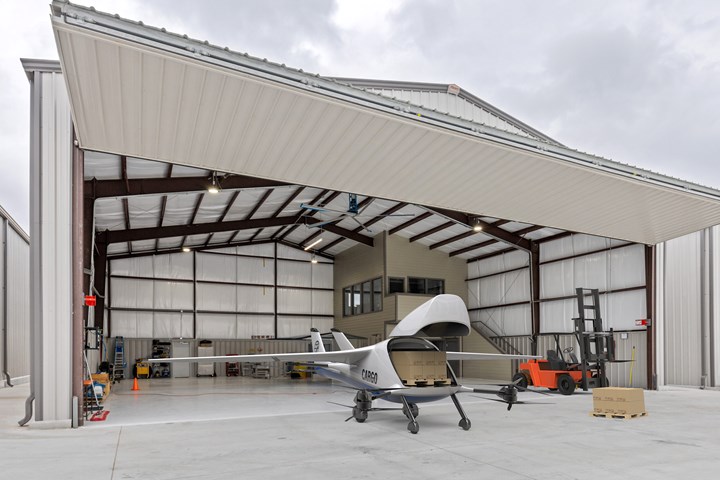 AIR One Cargo eVTOL
AIR One Cargo eVTOLElroy Air: This company is developing cargo eVTOL aircraft prototypes in partnership with NASA. The collaboration aims to learn more about these aircraft as they are being built and tested, focusing on integrating them into existing airport environments and airspace.
Reliable Robotics: Another company working with NASA on cargo delivery aircraft prototypes. Like Elroy Air, Reliable Robotics is part of NASA's efforts to research and develop solutions for moving more packages by air efficiently and safely.
Wrapping up:
Advanced Air Mobility (AAM) is gaining momentum as an integral part of the future transportation landscape, reshaping how we live, work, and connect.
China is making great strides in developing its low-altitude economy, planning to generate revenues exceeding 300 billion yuan (USD41.4 billion) in Guangdong province alone between 2024 and 2026. The Chinese government's strategy supports expanding AAM applications in agriculture, industry, logistics, and leisure while establishing a legal framework to facilitate development and manage risks.
States like Michigan are also investing heavily in AAM in the US. The state recently announced $6.25 million in funding for four projects to scale critical AAM infrastructure, deploy pilots, and generate data to validate the commercial potential of key use cases. These projects involve installing multimodal chargers at airports, launching proofs of concept for drone delivery services, and testing drones for healthcare and emergency response support.
AAM's significant market potential and societal benefits make it an exciting and promising industry. However, challenges remain, including high initial costs, extensive infrastructure, and regulatory hurdles. Collaborative efforts among manufacturers, technology firms, service providers, and government entities will be crucial in overcoming these challenges and realizing AAM's full potential to offer efficient, accessible, and environmentally friendly transportation solutions.

